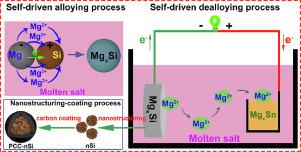Energy Storage Materials ( IF 18.9 ) Pub Date : 2020-10-24 , DOI: 10.1016/j.ensm.2020.10.021 Qiang Ma , Zhuqing Zhao , Yan Zhao , Hongwei Xie , Pengfei Xing , Dihua Wang , Huayi Yin

|
The nanostructuring of low-cost micro-sized silicon (mSi) is paramount to achieve the practical viability of deploying high-capacity Si anodes for lithium-ion batteries (LIBs). Conventional methods for converting mSi to nanoporous Si (nSi) involve low product yield, toxic chemical reagents, high energy consumption, etc. Herein, we report a self-driven alloying/dealloying approach to converting mSi to nSi in molten salts, where mSi alloys with Mg powders to generate Mg2Si and, subsequently, the Mg2Si dealloys in a Mg2Si||Sn primary battery with the production of nSi at the negative electrode and the liquid Mg-Sn alloy at the positive electrode. Finally, the Mg-Sn decomposes to Mg gas and liquid Sn through a vacuum-distillation process. Taking the micro-sized Si kerf waste as an example, the pyrolytic carbon-coated (PCC) nSi delivers a capacity of 1080.2 mAh g−1 at 1 A g−1 after 1000 cycles with a capacity retention rate of 83.7%. Furthermore, a fabricated PCC-nSi-2||LiNi0.6Co0.2Mn0.2O2 (NCM622) full cell demonstrates a high energy density of 466 Wh kg−1 as well as good cycling stability for 200 cycles. The improved Li-storage performance is attributed to the synergetic effects of the nanoporous Si and carbon coating. Overall, the self-driven nanostructuring approach along with the vacuum-distillation process maintains a high utilization of mSi, eliminates the use of toxic reagents, and keeps a closed-loop material circle, and thus offers an efficient and green pathway to valorize various mSi for making enhanced lithium-storage anodes.
中文翻译:

用于高性能锂离子电池阳极的纳米结构微硅的自驱动合金化/脱合金方法
低成本微米级硅(mSi)的纳米结构对于实现为锂离子电池(LIB)部署高容量Si阳极的实际可行性至关重要。将mSi转换为纳米多孔Si(nSi)的常规方法涉及低产品产率,有毒化学试剂,高能耗等。在此,我们报道了一种自驱动合金化/脱合金方法,可将熔融盐中的mSi转换为nSi,其中mSi合金用Mg粉末生成的Mg 2 Si和,随后,所述Mg 2的Si dealloys在镁2Si || Sn一次电池,负极生成nSi,正极生成液态Mg-Sn合金。最后,Mg-Sn通过真空蒸馏过程分解为Mg气和液态Sn。以超细碎屑为例,经过1000次循环后,热解碳涂层(PCC)nSi在1 A g -1下的容量为1080.2 mAh g -1,容量保持率为83.7%。此外,制成的PCC-nSi-2 || LiNi 0.6 Co 0.2 Mn 0.2 O 2(NCM622)全电池显示出466 Wh kg -1的高能量密度以及200次循环的良好循环稳定性。锂存储性能的提高归因于纳米多孔硅和碳涂层的协同作用。总体而言,自驱动纳米结构化方法与真空蒸馏过程一起保持了mSi的高利用率,消除了有毒试剂的使用,并保持了闭环的材料循环,从而提供了一种有效且绿色的途径来增值各种mSi用于制造增强型锂存储阳极。











































 京公网安备 11010802027423号
京公网安备 11010802027423号